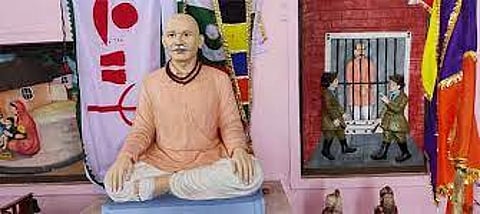
Jaipur- Udaipur MP Mannalal Rawat has raised objections against the portrayal of Govind Guru in a Class 9 Social Science textbook, which suggests that the revered tribal leader sought to establish a separate Bhil state. In his letter to Chief Minister Bhajanlal Sharma, Rawat highlighted that the assertion in the textbook is not based on historical facts but was a claim originally made by the British during the colonial period. Rawat pointed out that without proper verification, the Secondary Education Department included this erroneous information in the textbook.
The controversial statement appears in Chapter 4, page 42, of the textbook titled "Rajasthan ka Swatantrata Andolan evam Shaurya Parampara" (Freedom Movement and Valor Traditions of Rajasthan).
The book claims that the oppressive actions of feudal and colonial powers inspired Govind Guru and his disciples to plan the establishment of a Bhil state as a means of liberation from feudal and colonial bondage. Rawat argues that this statement is completely inaccurate, as Govind Guru was known for his spiritual teachings and non-violent resistance against British rule rather than for advocating a separate state.
In his letter, Rawat emphasized that Govind Guru was a proponent of the Bhakti movement. He guided his followers through devotional songs, encouraging them to combat social evils, awaken the public, and resist British rule. He was not driven by separatist ambitions but was dedicated to the upliftment of his people through spiritual awakening and social reform.
MP Rawat has called for the textbook to be amended in light of expert research and factual history. He insists that Govind Guru’s portrayal should align with his true legacy as a spiritual leader and social reformer. The textbook’s misrepresentation not only distorts historical facts but also undermines the nationalistic spirit of Govind Guru’s movement, Rawat emphasized.
Rawat urged the state government to revise the textbook content based on expert research and historical facts. He stressed that the portrayal of Govind Guru’s movement as a quest for a separate state was a misrepresentation inserted by the British in colonial records to undermine the nationalistic spirit of his efforts. According to Rawat, this narrative should not be perpetuated in educational materials that shape the understanding of history for young students.
Following Rawat’s complaint, the Chief Minister’s Office (CMO) directed the Rajasthan State Textbook Board to review the disputed content. The CMO ordered an immediate examination of the facts and directed the removal of the incorrect statements from the textbook.
The idea of a separate Bhil state, Bhil Pradesh, has its roots in the early 20th century. The demand was first articulated in 1913 by Govind Guru during a large tribal gathering at Mangarh Hill, a moment that ended in tragedy with the massacre of the tribals by the British. The movement was not just a call for a separate state but a larger struggle against the historical exploitation and marginalization of the Bhil community.
While the British had labeled Govind Guru’s efforts as a separatist movement, contemporary leaders argue that the demand for Bhil Pradesh today arises from ongoing socio-economic grievances and the need for recognition of the Bhil community’s cultural and historical identity. They see Bhil Pradesh as more than a territorial demand; it is a struggle against the injustices meted out to the community over centuries.
The Bhil community is demanding the formation of this separate state under Article 244(1) of the Indian Constitution, which provides for the creation of an autonomous state for certain tribes in India.
In southern Rajasthan, where tribal communities are predominant, the demand for a separate state gained momentum, driven by the Bhartiya Tribal Party (BTP), established in 2017 to represent tribals in Rajasthan, Gujarat, Madhya Pradesh, and Maharashtra.
BTP won two seats in the 2018 assembly polls in Rajasthan and gained traction over the past five years. Following internal splits, some BTP leaders formed a new party, the Bharat Adivasi Party (BAP), in September 2023, with the creation of Bhil Pradesh as a core agenda.
The envisioned Bhil Pradesh would comprise 49 districts from Rajasthan, Madhya Pradesh, Gujarat, and Maharashtra, where the Bhil population is concentrated.
The demand for a separate Bhil state involves the inclusion of the districts of Dungarpur, Banswara, Pratapgarh, Udaipur, Chittorgarh, and Sirohi, along with parts of Bhilwara and Jalore in Rajasthan.
In Madhya Pradesh, the demand extends to the districts of Ratlam, Jhabua, Raisen, Barwani, Mandla, Vidisha, Alirajpur, Dhar, Balaghat, Petlawad and Khargone. In Gujarat, it includes the districts of Dahod, Dang, Tapi, Narmada, Navsari, Panchmahal, Bharuch,Godhra and Botad and Nashik and Dhule in Maharashtra.
According to the 2011 Census, there are approximately 17 million Bhils in India, with significant populations in Madhya Pradesh (6 million), Gujarat (4.2 million), Rajasthan (4.1 million), and Maharashtra (2.6 million). This demographic distribution supports the case for a unified state reflecting the cultural and linguistic commonalities of the Bhil people.
You can also join our WhatsApp group to get premium and selected news of The Mooknayak on WhatsApp. Click here to join the WhatsApp group.